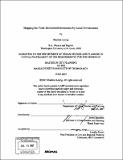| dc.contributor.advisor | James Hamilton. | en_US |
| dc.contributor.author | Leurig, Sharlene | en_US |
| dc.contributor.other | Massachusetts Institute of Technology. Dept. of Urban Studies and Planning. | en_US |
| dc.date.accessioned | 2008-01-10T16:05:47Z | |
| dc.date.available | 2008-01-10T16:05:47Z | |
| dc.date.copyright | 2007 | en_US |
| dc.date.issued | 2007 | en_US |
| dc.identifier.uri | http://hdl.handle.net/1721.1/39945 | |
| dc.description | Thesis (M.C.P.)--Massachusetts Institute of Technology, Dept. of Urban Studies and Planning, 2007. | en_US |
| dc.description | Includes bibliographical references (p. 91-93). | en_US |
| dc.description.abstract | Brownfields are abandoned or underused land whose redevelopment is complicated by the presence or perception of contamination. Nationally the United States Environmental Protection Agency estimates the number of brownfields to be more than half a million. As of 2002, the EPA requires states and tribal governments to inventory brownfields within their boundaries in order to receive federal funding for brownfield response programs; municipalities and regional planning offices eligible for competitive EPA brownfield grants are encouraged to first conduct a brownfield inventory. Assessment grants funding inventories are open-ended, allowing local governments to define their own methods of identifying brownfields and prioritizing parcels for redevelopment; as such there is little documentation of the way inventories are conducted. Through interviews with brownfield redevelopment professionals and inventory makers in Alabama, California, Kentucky, Massachusetts and New Jersey this thesis explores the ways local governments prioritize property types for identification, how they locate brownfields, how they incorporate community knowledge, and how inventories influence subsequent public funding allocations. | en_US |
| dc.description.abstract | (cont.) This research indicates that inventories tend to focus on large sites close to infrastructure with the intention of marketing individual properties rather than strategically incorporating brownfield redevelopment into broader urban or regional planning. While local governments frequently design inventories in partnership with and for use by non-government actors, they tend to work almost exclusively with other professional groups and have marginal success at soliciting community participation. Though inventories are meant to capture brownfields that have eluded regulatory databases of contaminant release reports, fear of litigation from injured property owners and reliance on official property records bias inventory results to represent only the most visible brownfields. I conclude that the EPA should work with planning professionals to educate inventory makers on ways of creating strategic inventories. I also assert that brownfield inventories must include community partnerships in order to align brownfield redevelopment with community objectives and explore the legal and political implications of such partnerships. | en_US |
| dc.description.statementofresponsibility | by Sharlene Leurig. | en_US |
| dc.format.extent | 93 p. | en_US |
| dc.language.iso | eng | en_US |
| dc.publisher | Massachusetts Institute of Technology | en_US |
| dc.rights | M.I.T. theses are protected by copyright. They may be viewed from this source for any purpose, but reproduction or distribution in any format is prohibited without written permission. See provided URL for inquiries about permission. | en_US |
| dc.rights.uri | http://dspace.mit.edu/handle/1721.1/7582 | |
| dc.subject | Urban Studies and Planning. | en_US |
| dc.title | Mapping the void : brownfield inventories by local governments | en_US |
| dc.type | Thesis | en_US |
| dc.description.degree | M.C.P. | en_US |
| dc.contributor.department | Massachusetts Institute of Technology. Department of Urban Studies and Planning | |
| dc.identifier.oclc | 183196642 | en_US |
